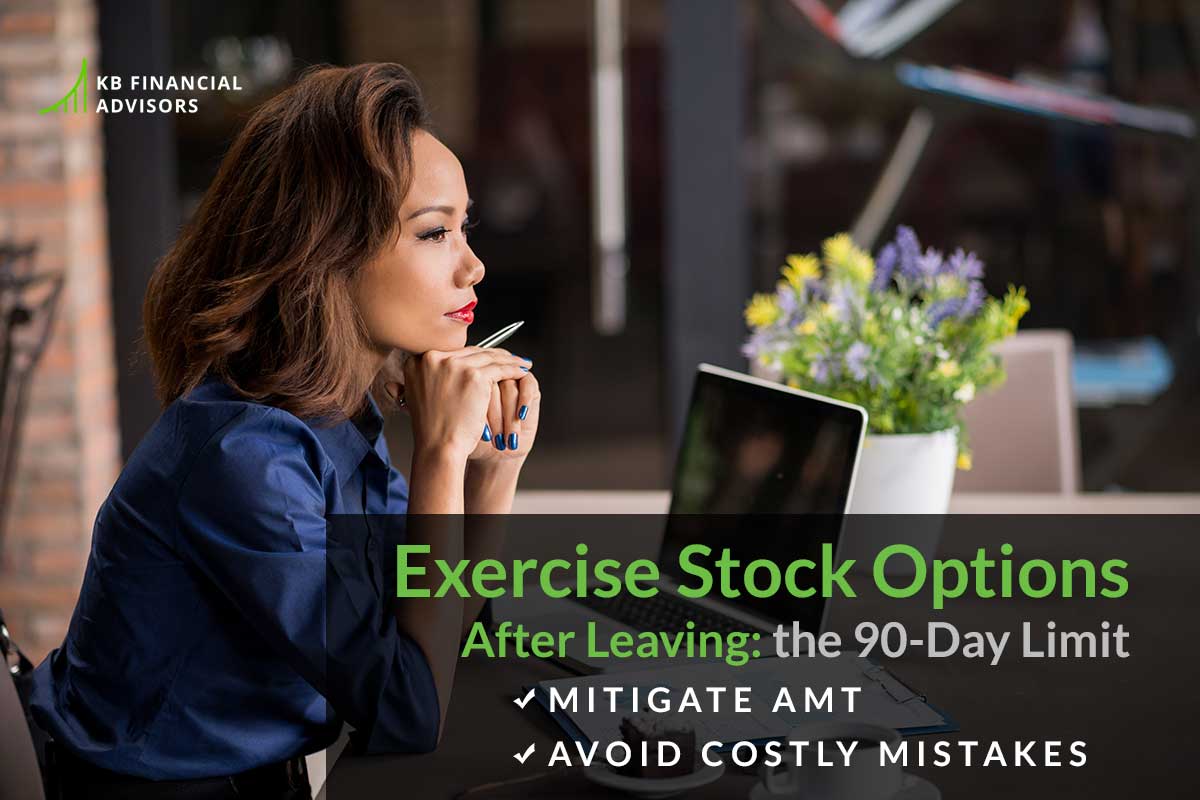[et_pb_section fb_built=”1″ _builder_version=”4.19.4″ _module_preset=”default” global_colors_info=”{}”][et_pb_row _builder_version=”4.19.4″ _module_preset=”default” global_colors_info=”{}”][et_pb_column type=”4_4″ _builder_version=”4.19.4″ _module_preset=”default” global_colors_info=”{}”][et_pb_text _builder_version=”4.19.4″ _module_preset=”default” global_colors_info=”{}”]Your days at the company are numbered.
Maybe you’ve gotten a job elsewhere, been laid off, or are taking that long-awaited sabbatical.
Unfortunately, you’ve just realized that moving on to the next thing wasn’t as easy as sending goodbye messages to your work buddies on Slack and turning in the company laptop. Unbeknownst to you, your financial life just got a lot more complicated.
Exercise Stock Options After Leaving with Vested ISOs
Let’s say you’ve been blessed to work for a good company:
You accepted a job offer that gave you a sign on bonus and stock options, and the company’s continued to grow and grant you more and more stock options over the years. Your strike price is nominal, meaning you can literally buy company stock for pennies on the dollar.
All-in, your vested options represent seven to eight figures.
Yeah, that’s nothing to blink at.
The problem is, you’ve already left.
And you’ve only got 90 days to exercise stock options after leaving… or be forced to kiss that potential wealth goodbye forever.
Plus… you realize that exercising those bad boys over the next three months is going to result in the ugliest tax bill you’ve ever seen.
Fortunately, there is a light at the end of the tunnel, which I’m going to walk you through in this post.
Please note, this post merely includes aspects of planning for a scenario like this, to mitigate AMT and avoid costly mistakes. Every individual’s financial landscape is different, so applying identical strategies to different people could actually adversely affect one person’s plan, even if it’s good for the other.
What follows in this post are guidelines, but to get the best plan pinned down for you, book a call with one of our expert financial planners today.
Make the Alternative Minimum Tax… Less Taxing
Stock Option Tax Timing
If the 90-day window to exercise stock options after leaving carries into the next calendar year, you can utilize this strategically. By exercising specific lots in the current and following calendar year, you can break up the taxes owed across those calendar years, making your tax bill a little more bearable.
For example, if your final day with your employer is on October 31st of this year, then the 90-day window spans from November 1st of the current year, through January 29th of the following.
This gives you an advantage, especially if you anticipate your taxable income will be very different between this year and next.
December 31, then, becomes your line in the sand date: an option exercised on or before this day will count towards the current tax year, but one exercised on January 1 or later will count towards next year’s tax return.
If you know that your income will be a lot higher this year than next year, for example, you could benefit from exercising a small amount of ISO this year, and the rest next year—reducing AMT.
Create a Disqualifying Disposition
In an ideal world, you’d be able to hold your ISOs until they meet the qualifications for long-term capitals gains tax rates (sometimes also called preferential tax treatment), so you can save money on any gains you make upon selling the stock:
- More than one year after exercise, and
- More than 2 years after grant
Unfortunately, this isn’t always possible when you’ve only got 90 days to act.
But if you sell the stocks before they qualify for lower tax rates?
This is referred to as a disqualifying disposition, or early disposition.
As the name suggests, you are disposing (selling) the stock early (prior to meeting holding period requirements), effectively disqualifying the stock for being taxed at the lower rates. Instead, the gain recognized will be taxed under the higher, ordinary income tax rates.
And believe it or not, a disqualifying disposition could actually be beneficial.
How?
In this case, you need the cash to pay the taxes you’ll owe. Given the 90 day timeline to exercise all remaining vested options, it’s likely that you’ll face a large tax bill when you run the final AMT calculation.
By selling shares after exercise, you can use the proceeds to cover your tax liability. Although we won’t go into great detail here, selling shares in the same tax year effectively excludes those particular shares from being included in the calculation of AMT, which can be a huge benefit for you.
????Said differently, you can eliminate AMT if you were to sell all shares within the same tax year they were exercised. The tradeoff being that the recognized gain would be taxed as ordinary income in the current year, instead of long-term capital gains in subsequent years. Neither is good or bad; it all just depends on your plan and financial situation.
Finding Cash to Pay the Tax Bill… Without Selling ISO
Selling shares to cover taxes would be one way to pay for the tax bill that’s on its way, but what if you’d rather not do that?
If you don’t have the cold cash just sitting in the bank, take a look at assets you’ve acquired, many of which may have appreciated over time.
If we took a snapshot of your balance sheet, we might find cash savings, a few taxable brokerage accounts that hold ETFs and company stock, crypto currency, Rollover and Roth IRAs, a 401(k), deferred compensation plans, your personal residence, rental property(ies), and a few liabilities such as mortgages, student loans, and credit cards with nominal balances that are paid off each month.
The primary places to find resources to pay the tax bill on your balance sheet would be bank accounts and taxable investment accounts.
Although there are ways to generate liquidity from other assets, there are limitations and risks you want to avoid. Borrowing on margin, pledging retirement assets, or leveraging equity in property to pay a tax bill just compounds the risk you bring to your financial situation, and that’s not what we want.
When reviewing your brokerage accounts, you may realize that you’ve got some or all the resources needed to pay the bill. Within your accounts, you may be holding stocks, bonds, ETFs, mutual funds, and various crypto currencies.
Additionally, the values have changed since you’ve purchased each investment, and you could find sizable built-in gains that will help you pay the tax bill.
In cases like this, develop a smart approach with your financial advisor where you measure each move against your long-term financial strategy. It’ll help you avoid making costly mistakes when deciding what to sell, and how much.
Plan Your Exercise Strategy: Work With a Financial Team
I shared just a few areas to consider when facing a super short window to exercise all your vested options, so here’s a list of a few more areas to consider:
- Decisions based on stock price
- Maximizing AMT credits in future years
- Desire to keep or sell specific amounts
- Tax filing status
- Household income/assets
- Charitable inclinations
- Managing risk of concentrated investment
- Other equity compensation (RSUs/NSOs)
- Early founder eligible for Qualified Small Business Stock
- Election of 83(b)
The best way to avoid costly mistakes, of course, is to have a team of financial professionals on your side who know exactly what to avoid from a tax perspective, and exactly how to maximize any profit you’ll get from exercising your ISO.
Grab a time to meet with one of us, and we’ll be happy to walk you through what we can do for you.
[/et_pb_text][/et_pb_column][/et_pb_row][/et_pb_section]



